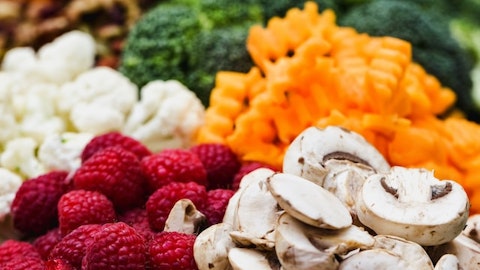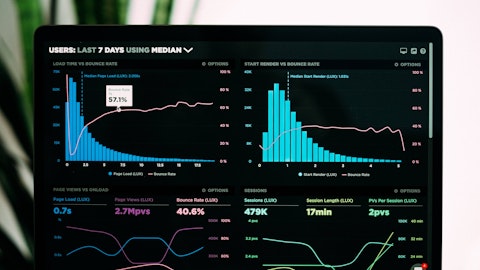Q – Thomas Palmer: Okay. Thanks for that. And then I know you’d — you kind of answered on the promo flexibility or the commitment to it. What about marketing dollars? Because that is more back half-weighted. There is probably more of the element of discretionary I guess. Is there a thought of kind of flexing that bit, if demand is so high that you don’t really need the incremental demand to build? Or marketing decisions maybe more long-term oriented where that ‘s not as much of a consideration, as you think about this year?
Darcy Davenport: We definitely have more flexibility on marketing because yes, it’s in our control. We are already supporting our powder side of the business, as well as we are doing some support around bottle because and we don’t have constraints there. So — but as for kind of the broader equity support around the Tetra side of the business, which is the lion’s share, we do have our flexibility. We’re currently developing our campaign that we plan to launch in Q4. And as you guys know the impact of marketing isn’t always immediate. It’s more of a long-term play. So we’ll make those decisions later and that we usually — you usually have to make those decisions within kind of couple of months of launch. So, we have a little time to evaluate if we’re going to launch as expected maybe go a little lighter or wait.
Thomas Palmer: Okay. Thank you.
Operator: Thank you. Bryan Spillane Bank of America.
Bryan Spillane: Hey thanks operator. Good morning everyone. I think just a couple of quick ones for me. Really for you Paul is one just I guess as we’re thinking about the cadence on pricing. Will it — like just whether Q2 would be down the most I guess of the quarters for the balance of the year? Just if you can give us some sense. Even just at a total company level how we’re thinking about the cadence on pricing over the balance of the year?
Paul Rode: Yes absolutely. The second quarter should be the biggest impact for pricing as we have significant promotions going on in most of our channels. So, that would certainly be the biggest pricing headwinds from — as we go through the quarters. The rest of quarters are fairly balanced. Slight headwinds, but that’s really the second quarter where it’s the most meaningful.
Bryan Spillane: Okay. And is this year — should this be a pretty good year as we’re kind of modeling the out years and thinking about the timing of promotions. There is some seasonality. Is this sort of a normal years we’re beginning to kind of do the out — model the out years in terms of just the flow of promotions and the seasonality in the business?
Paul Rode: Yes. As we go forward, we’d expect the second quarter will always be kind of the heaviest period as that’s just when a lot of consumers come into the category. So, yes, we expect the second quarter is typically the heavier promotional period. The fourth quarter is kind of the next. We don’t typically promote much in the first quarter as a seasonally low consumption period. And then the third quarter is kind of somewhere in between. Not usually a lot of promotion in the third quarter. I’d say the only difference from how this year is playing out is we typically also spent heavier marketing behind our shakes. In the second quarter, we are not doing that as we’ve talked about earlier on this call with just as we’re continuing to manage supply and demand. But we do expect it to ramp up in the fourth quarter. So, that’s the only difference. But from a promotional calendar, yes, it’s primarily due to a bit in Q4 than in Q1 and Q3 are typically fairly light.
Bryan Spillane: All right. Cool. And then just one last one. Just I think you said earlier that 2Q SG&A as a percentage of sales is going to be higher. I’m just wasn’t sure is it higher than the first quarter, higher versus last year? I just wanted to clarify that.
Paul Rode: Yes, the comment was higher than last year.
Bryan Spillane: Okay. Year-over-year percentage as a percentage of sales it will be higher this year than last year?
Paul Rode: Modestly higher, correct.
Bryan Spillane: All right, cool. That’s it for me. Thank you.
Paul Rode: Thank you.
Operator: Thank you. Our next question comes from the line of Bill Chappell from Truist Securities.
Bill Chappell: Thanks. Good morning.
Darcy Davenport: Thank you.
Bill Chappell: Darcy just cannot get arms around where we go from here and in terms of household penetration. And for ready-to-drink shake you said Premier’s now at 17%, which is almost one in five households. And some would say not one in five households actually eat breakfast each morning. So, if you look at the next kind of eat points getting 25%. Does that come from bar users? Does that come from energy drink users? Does that come from lunch or dinner? Or is — do you see a lot of kind of backfill of each households who are in the 17% are having two shakes a week, need to go to three shakes or four shakes or five shakes. So, how do you see that going to play out over the next few years?
Darcy Davenport: I mean historically, about 80% of our growth is coming from outside of the category. So, I’m not sure I can tell — when I say outside of the category, I mean outside of the convenient nutrition category. So these are people who are trying to make a better decision and trying to be healthier. And so, whether they drink energy, drinks or not. It’s just outside of the category. And then and in that — I mean we believe that there is a ton of upside. I mean you look at the household penetration just the category and of liquids are ready-to-drink about 45%, bars is about 54%, energy drinks is 69%. So, I think that — and most mature CPG companies are up in the 80% to 90%, some even higher. So we think that there’s a ton of room to grow within just adding people given all the macro trends that are going on around protein is good for you, healthy eating convenience.
And not even to mention everything going on with GLPs. So we think there’s a ton of tailwinds more people leaning into the category and we’re positioned well.
Bill Chappell: Okay. And then just — again, I know you explained this before, but the importance of the tetra packaging, because I mean I think you just said on the last one, obviously you don’t have capacity constraints on the bottles. And so why would not just go all bottles? Help us understand the importance of that on the packaging and into the brand into the story?
Darcy Davenport: Well, part of this just numbers. So, if you think of — and when I say we don’t have to have capacity constraints on bottles. The overall network of bottles is constrained. But I mean bottles are 10% of our business. So it’s virtually impossible to convert the entire business to bottles. There just isn’t enough. We find that our consumer really likes the tetra pack, another also consumers that like bottles. So I think that it’s less about what’s important is what’s inside the bottle — what’s inside the package. And I think that, so it’s less about we will get to — we have invested in our tetra pack network. And I feel like we are in kind of sitting distance to be unconstrained, which I think we expect that by the time we get into 2025, we will be managing to a demand number and not a supply number. So again, I think that they both have their place but our consumers consistently stated that they do like the tetra.
Bill Chappell: Great. Thanks so much.
Darcy Davenport: Thanks.
Operator: Thank you. One moment for our next question. Our next question comes from the line of Matt McGinley from Needham.
Matt McGinley : Great. Thank you. With your seasonal flavors and Premier, do you expect to see more seasonal ebbs and flows in TDPs and ACV related to those limited time flavors, and overtime would you expect the shipments related to the seasonal flavors to create a little more seasonality in your sales volumes? Or do you think your core SKUs really just pick up a slack whenever those seasonal flavors get depleted at your customers?
Darcy Davenport: What’s great about our seasonal strategy now is we have one for every season. So in essence, it’s just a rotating spot, and consumers get excited. So we basically go from Pumpkin’s Spice or beginning the winter mint chocolate to a summer seasonal. It was [indiscernible]. And it’s now salted Caramel Popcorn. It then goes into Pumpkin Spice and then rotates around again. So the idea is that we in essence always have a seasonal flavor out there, although what that flavor is may change.
Matt McGinley : Got it. And last quarter, you noted that your the biggest factor for you to hit the high end of your guidance would likely be the timing of production. Is the timing of ramp production capacity? Is that still the critical factor to reach the high end of your new guidance? Or is the high end of the guidance now more contingent upon the effectiveness of marketing or promotion that you just might have less visibility into?
Darcy Davenport: Steel production scale-up.
Matt McGinley : Okay. Thank you very much.
Darcy Davenport: Thank you.
Operator: Thank you. One moment for our next question. Our next question comes from the line of Kaumil Gajrawala from Jefferies.
Kaumil Gajrawala : Do you hear better now? You guys hear me now?
Darcy Davenport: Yes. We hear you.
Paul Rode : Yes.
Kaumil Gajrawala : Okay. Sorry about that last time. I want to talk — you maybe not so quietly been talking about being the powder side. It seems like every very time we chat, you’re talking about it a little bit more. Can you maybe just talk about the differences in the consumers that you’re bringing in on powder, how it interacts with the core product? Maybe anything on incrementality. Any more color there would be helpful.
Darcy Davenport: Yes. Ready-to-drink in powders are very complementary. For the most part, one is a little bit more on the go, being ready to drink. The other one powder is used mostly in the house. And then just from an occasion standpoint, I talked about the occasion for the most part of ready-to-drink is a breakfast replacement, whereas powders are more used after a workout. The consumer also can be — most powders are going more toward the athlete. However, that’s the opportunity for Premier is really bringing in those mainstream consumers. The other piece is powders are more often used with other foods, so making smoothies or throwing it in pancakes to make a high protein pancake or as ready-to-drink are used that way, usually just consumed right out of the Tetra of the bottle, because very complementary.



